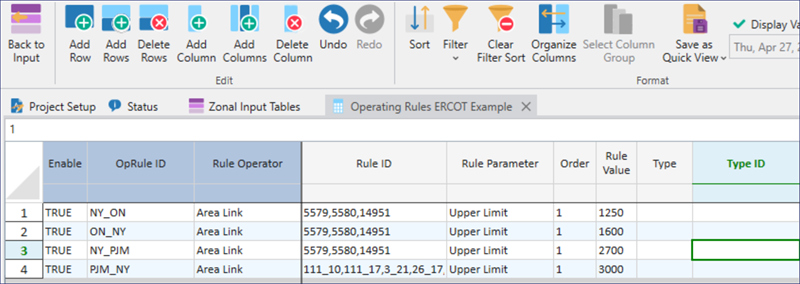Operating Rules Table
The Operating Rules table is used to specify reliability must run (RMR) units, set generation limits for groups of resources, and for applying multi-link transfer limits (e.g. corridors, nomograms).
For RMR or generation limits, the table designates conditional rules under which resources must operate. It allows the designation of commitment and generation based on Zone or Pool demand levels. These are specified by Rule Operator = Resource. Resources participating in the rule are listed in the Rule ID column.
To specify commitment rules (RMR) use Rule Parameter = Committed/Committed MW. The model will attempt to find the least cost resources to honor the requirement by ranking the available options by cost. If the Rule Parameter = Committed MW (the total MW to be committed), the cost ranking will be on a $/MWh basis. If the Rule Parameter = Committed (count of units), the cost ranking will be based on $/MWh * Minimum Capacity.
Resources in the RMR rule should be designated as Non-cycling units. RMR (Reliability Must Run) designation of units is not available for Economic Commitment. Pool-based Commitment (i.e., reliability-based commitment) or Commitment Optimization must be enabled for these functions to work. When using pool-based commitment, additional Debug Messaging (Level 3) is available to inform which hours in the current commitment window the operating rules are in effect. The order of output in the Status Window indicates the order that each rule will be processed.
To specify generation limits use Rule Parameter = Generation MW. This option will constrain the total hourly generation from the group of specified resources. The Rule ID specifies a comma delimited list of resources, including the option for multipliers, and the Rule Relation column is used to designate whether the limit is an upper, lower, or equality constraint. Currently these rules will only apply to the zonal solution.
For multi-link transfer limits, the table defines flow limits for multiple area, zone, or pool level transmission links using the Rule Operator as the starting point. This feature has the ability to force known flows across links or set limits based on a relationship to demand values (e.g., nomograms).
![]() NOTE: Pool/Zone Import and Export constraints are adjusted for losses so that the import/export used in the constraint is what actually gets into/out of the region. The import constraints, and the export constraints when the Link Limit Type = Net, are calculated using the Flow In After Losses. The Flow Out used in these constraints (where applicable) uses the pre-loss amount. Note that the Area Link and Zone Link constraints are always pre-loss in both directions.
NOTE: Pool/Zone Import and Export constraints are adjusted for losses so that the import/export used in the constraint is what actually gets into/out of the region. The import constraints, and the export constraints when the Link Limit Type = Net, are calculated using the Flow In After Losses. The Flow Out used in these constraints (where applicable) uses the pre-loss amount. Note that the Area Link and Zone Link constraints are always pre-loss in both directions.
|
COLUMNS INCLUDE |
|||


![]() Operating Rules Table
Operating Rules Table
